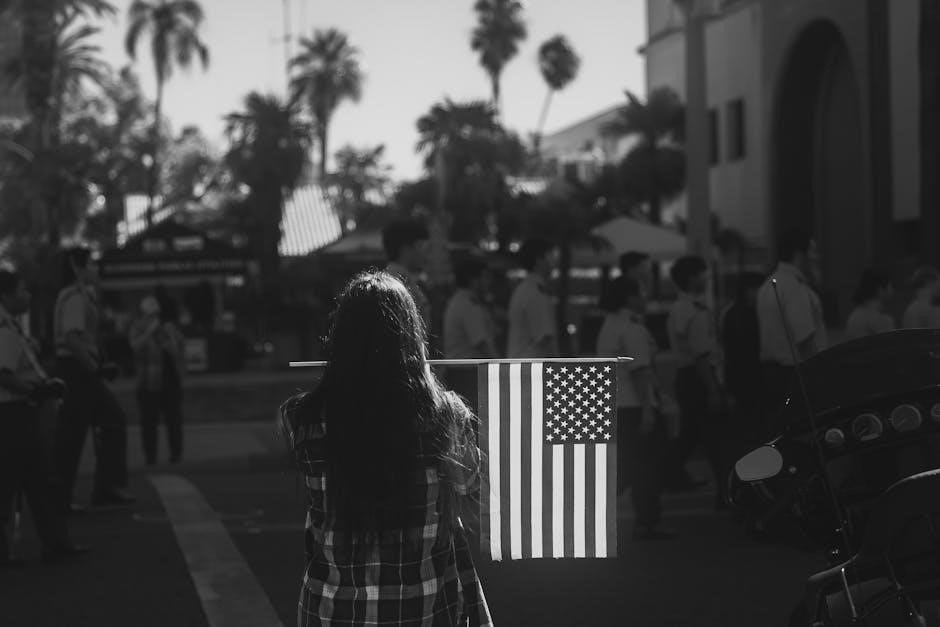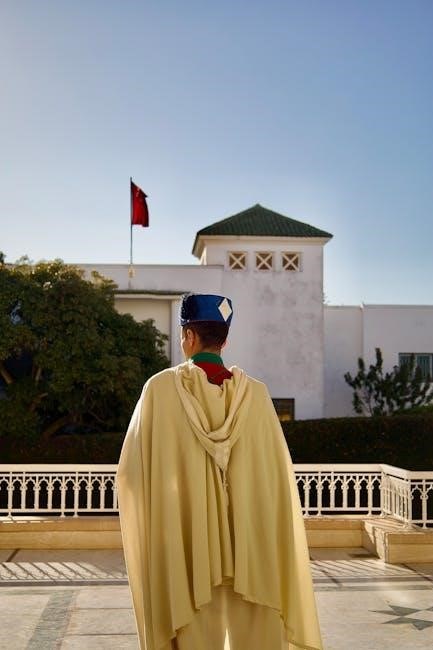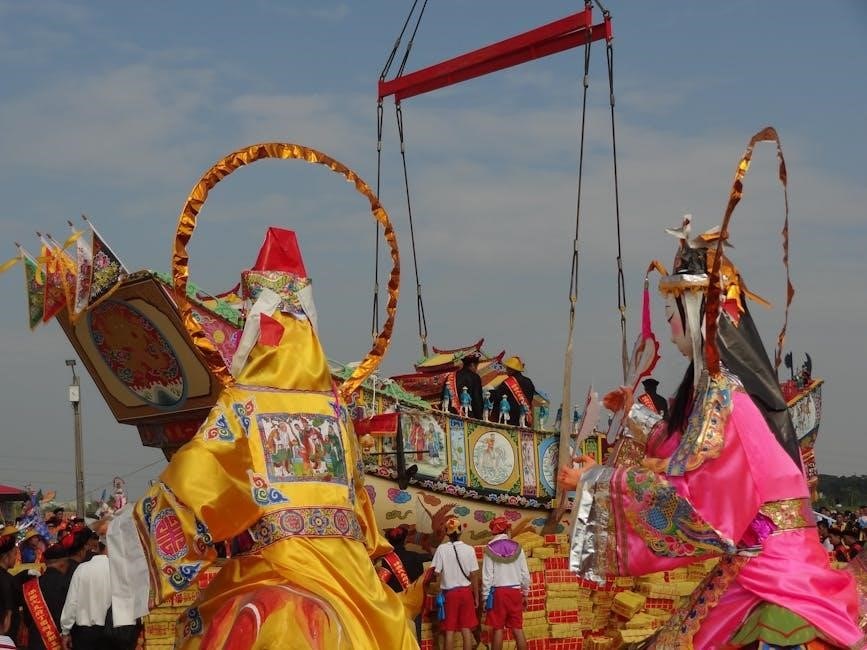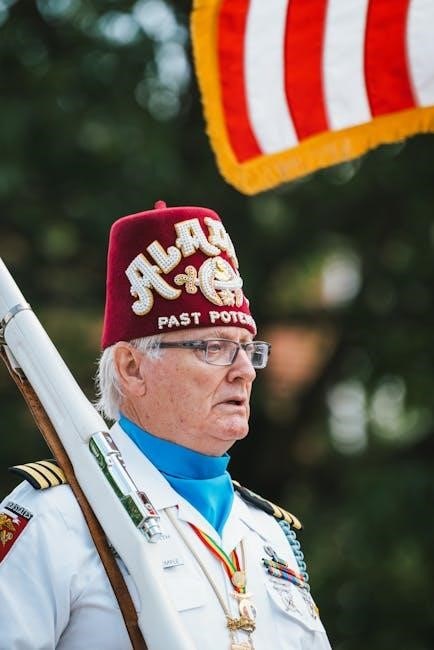A Cub Scout flag ceremony is a meaningful tradition that teaches patriotism and respect for the American flag. It is a solemn yet simple event, designed to help young scouts understand the importance of citizenship and national pride.
Importance of Flag Ceremonies in Cub Scouts
Flag ceremonies are a cornerstone of Cub Scout activities, fostering patriotism, respect, and a sense of duty among young scouts. These ceremonies provide a meaningful way to teach children about the significance of the American flag and its role as a symbol of national unity and pride. By participating in flag ceremonies, scouts learn about citizenship, honor, and the importance of respecting national symbols. Such events also serve as opportunities to reflect on the values of scouting, including loyalty, courage, and service to others. The ceremonies are often conducted during meetings, camps, and special events, making them a consistent and impactful part of a scout’s education. They also help scouts develop leadership skills, as they take on roles such as flag bearers or leaders of the Pledge of Allegiance. Ultimately, flag ceremonies inspire scouts to become responsible and patriotic citizens, laying the foundation for a lifelong commitment to their community and country.
Benefits of Participating in Flag Ceremonies
Participating in flag ceremonies offers numerous benefits for Cub Scouts, fostering personal growth and a deeper understanding of civic responsibility. These events provide opportunities for scouts to develop leadership skills by taking on roles such as flag bearers, narrators, or color guards. Engaging in ceremonies teaches respect for national symbols and reinforces the values of patriotism and loyalty. Scouts also learn proper flag etiquette, including how to handle, display, and fold the flag correctly. Additionally, these ceremonies promote teamwork as scouts work together to ensure the event runs smoothly. The experience builds confidence, as young scouts perform in front of their peers and community members. Flag ceremonies also serve as a platform for scouts to reflect on the importance of unity and the principles of Scouting. By participating in these meaningful events, scouts gain a sense of pride and responsibility, which are essential for their development into capable and caring individuals. These experiences remain with them as they grow, shaping their character and commitment to their community and country.

Preparation for a Flag Ceremony
Preparation for a flag ceremony involves inspecting the flag for damage, assigning roles like color guard and narrators, and rehearsing the steps. Ensure flag stands are set up correctly, and all participants understand their responsibilities to maintain dignity and respect during the event.
Understanding Flag Etiquette
Flag etiquette is crucial in Cub Scout flag ceremonies to show respect for the American flag, a symbol of national pride and unity. Key principles include keeping the flag higher than any other flags when displayed together and ensuring it is always to the right. The flag should never touch the ground or be folded carelessly. During ceremonies, participants should face the flag, remove hats, and salute appropriately. Scouts should avoid draping the flag over shoulders or using it as decoration. Proper folding techniques, such as the ceremonial triangle fold, must be followed to maintain dignity. Teaching these practices helps Scouts develop a deep respect for the flag and their country, fostering patriotism and citizenship. By adhering to these guidelines, Cub Scouts honor the flag’s significance and uphold its legacy as a symbol of freedom and unity.
Roles and Responsibilities in the Ceremony
In a Cub Scout flag ceremony, each participant has a specific role to ensure the event is conducted with respect and precision. The color guard typically consists of the U.S. flag bearer, den flag bearer, and their respective guards. The U.S. flag bearer leads the procession, followed by the den flag bearer, and both must maintain the flags upright and steady. Guards assist in holding and presenting the flags during the ceremony. The audience plays a vital role by rising, saluting, and remaining silent during key moments, such as when the flags are presented or retrieved. Leaders, including den leaders or Scoutmasters, are responsible for directing the ceremony, ensuring timing and etiquette are observed. Other Scouts may participate as readers, reciting the Pledge of Allegiance, Scout Oath, or additional patriotic texts. Parents and guests are expected to follow flag etiquette and support the Scouts in their roles. Proper execution of these responsibilities ensures a dignified and meaningful ceremony.
Setting Up the Ceremony Area
Properly setting up the ceremony area is essential for a respectful and organized Cub Scout flag ceremony. Begin by positioning the U.S. and den flags in stands at the front of the room, ensuring the American flag is on the left when facing the audience. The color guard should line up in the back, ready to advance when directed. Audience seating should be arranged so everyone can see the flags and participate in the ceremony. Leave the center aisle clear for the color guard to walk through.
If indoors, place the flag stands in a visible location, such as a stage or at the front of the room. If outdoors, secure the flags in stands or poles and ensure the area is clear of obstacles. The color guard should form a straight line, with the U.S. flag bearer leading, followed by the den flag bearer and guards. Audience members should be seated quietly, with leaders or Scouts assisting in guiding them to their places. Proper setup ensures a smooth and dignified ceremony.
The Opening Flag Ceremony
The opening flag ceremony begins with the color guard advancing to the front. The audience rises and salutes as the colors are presented. The Pledge of Allegiance is recited, followed by the Scout Oath and Law, fostering unity and respect.
Steps for Presenting the Colors
The presentation of the colors is a dignified and orderly process that begins with the color guard advancing to the front of the ceremony area. The color guard, typically consisting of Scouts, carries the American flag and the Cub Scout pack or den flag. The audience is asked to rise and salute as the colors are presented. The color guard halts in front of the flag stands, turns to face the audience, and carefully places the flags in their respective stands. The American flag is always positioned to the right (audience’s left) to show proper respect.
Once the flags are in place, the color guard steps back and salutes. The audience is then invited to recite the Pledge of Allegiance, followed by the Scout Oath and Law. This solemn process ensures the ceremony begins with unity and respect. The Scouts involved in the color guard are expected to maintain focus and proper posture throughout the presentation.
After the flags are presented, the color guard retires to their positions, and the ceremony proceeds with additional elements, such as speeches or awards. The presentation of the colors sets the tone for the entire event.
Reciting the Pledge of Allegiance
The Pledge of Allegiance is a cornerstone of Cub Scout flag ceremonies, fostering patriotism and unity among participants. It is typically recited immediately after the presentation of the colors, with the audience rising and saluting the American flag. Scouts and leaders alike participate, demonstrating respect for the nation and its symbols.
The Pledge is led by a designated Scout leader or adult, who begins by prompting the audience to stand and place their right hand over their heart. Scouts in uniform may also render a salute. The words of the Pledge are spoken in unison, emphasizing collective commitment to the country and its ideals.
This moment serves as a powerful teaching tool, helping young Scouts understand the significance of citizenship and loyalty. Proper etiquette is emphasized, ensuring the ceremony remains respectful and meaningful. The Pledge of Allegiance is a simple yet profound act that reinforces the values of Cub Scouting.
Incorporating the Scout Oath and Law
The Scout Oath and Law are integral components of Cub Scout flag ceremonies, reinforcing the values of citizenship, character, and community. After the presentation of the colors and the Pledge of Allegiance, Scouts are invited to recite the Scout Oath and Law, further solidifying their commitment to Scouting principles.
The Scout Oath is recited first, with Scouts raising their right hand in the Scout sign as they pledge to “do my best to God and my country.” This is followed by the Scout Law, which outlines 12 points of conduct, such as being trustworthy, loyal, and reverent.
Incorporating these elements into the flag ceremony emphasizes the connection between patriotism and Scouting values. It teaches young Scouts the importance of living by a moral code and striving to be their best selves. Leaders often take this moment to remind Scouts that these promises extend beyond the ceremony, guiding their actions in daily life.
This practice not only enriches the ceremony but also helps Scouts develop a stronger sense of duty and responsibility to their communities and nation.

The Closing Flag Ceremony
The closing flag ceremony respectfully concludes the event, often with the color guard retrieving the colors. The audience salutes as the flag is slowly lowered and removed. Proper folding techniques are demonstrated, emphasizing respect and gratitude. The ceremony ends with a dismissal, leaving a lasting impression of patriotism and unity.
Steps for Retrieving the Colors
Retrieving the colors is a dignified process that concludes the flag ceremony. The color guard, led by a designated leader, advances to the flag stands. Upon reaching the flags, they halt and prepare to remove the colors. The audience is instructed to rise and salute as the flags are carefully lifted from their stands. The American flag is retrieved first, followed by any other flags, ensuring they are held high to maintain respect. The color guard then slowly exits the ceremony area, maintaining formation and decorum. Once the flags are safely outside, the audience is dismissed from their salute. The process emphasizes respect for the flag and reinforces the values of citizenship and patriotism among scouts and participants. Proper etiquette is upheld throughout, ensuring the ceremony remains meaningful and honoring the symbols it represents.
Proper Flag Folding Techniques
Properly folding the American flag is a symbolic act that demonstrates respect and patriotism. The flag should be folded into a triangular shape with 13 folds, each representing a specific aspect of American heritage, such as life, purity, and honor. The process begins with two people standing facing the flag, holding it horizontally at waist height. The flag is then folded in half lengthwise, with the stripes facing upward. This step is repeated, ensuring the flag remains aligned and smooth. The final folds create the distinctive triangular shape, symbolizing the tricorn hats worn by patriots during the American Revolution. Once folded, the flag is held at shoulder height and presented with dignity. This technique is a vital part of flag ceremonies, teaching scouts the importance of respecting the flag and understanding its symbolic meanings. Proper folding ensures the flag remains a cherished and honorable representation of the nation.
Dismissing the Audience
Properly dismissing the audience is an essential part of concluding a Cub Scout flag ceremony. Once the flag has been folded and the final words or songs are complete, the leader should thank everyone for their participation and attention. This step ensures the ceremony ends on a respectful and organized note. The leader may say something like, “Thank you all for participating in this meaningful ceremony. You may now be seated and are dismissed.” If the ceremony is part of a larger event, the leader might also provide instructions for what comes next. It’s important to maintain a dignified tone throughout the dismissal to uphold the ceremony’s significance. The color guard should exit first, followed by the audience, ensuring an orderly process. This final step reinforces the values of respect and discipline that the ceremony aims to instill in the scouts and attendees alike.

Flag Retirement Ceremonies
A flag retirement ceremony is a respectful way to dispose of worn or damaged U.S. flags. Cub Scouts often participate by separating stars from stripes and properly burning or burying them. This teaches the importance of honoring the flag and its symbolism.
When and How to Retire a Flag
A U.S. flag should be retired when it becomes worn, torn, or no longer suitable for display. Cub Scouts often conduct flag retirement ceremonies to teach respect for the flag and its symbolism. The process involves carefully separating the flag into parts, such as the stripes and stars, before proper disposal.
The flag should never be intentionally damaged or defaced during retirement. Instead, it is typically burned in a respectful manner, with ashes buried afterward. Scouts are encouraged to participate in this solemn event to understand the significance of honoring the flag.
Flag retirement ceremonies are often held on patriotic occasions, such as Flag Day or Veterans Day. These events provide an opportunity to educate youth about the importance of proper flag etiquette and the meaning behind the flag’s colors and design. By involving scouts in the process, leaders instill a sense of responsibility and patriotism. Proper disposal ensures the flag is treated with the dignity it deserves, reflecting respect for the nation it represents.
Conducting a Respectful Retirement
Conducting a respectful flag retirement ceremony is a meaningful way to teach Cub Scouts about patriotism and proper flag etiquette. The ceremony should be organized with dignity, ensuring all participants understand the significance of the event.
The process begins with inspecting the flag to confirm its condition. If it is worn or damaged beyond repair, it is ready for retirement. Scouts should be educated on the symbolic meaning of each part of the flag, such as the stripes representing the original colonies and the stars symbolizing the states.
During the ceremony, the flag is carefully unfolded and separated into its components. The stripes and stars are then respectfully disposed of, often through burning, to prevent improper use. Scouts are encouraged to reflect on the values the flag represents, such as freedom and unity.
Leaders should guide the ceremony with clear instructions, ensuring it remains solemn and focused. Involving youth in the process helps them develop a deeper appreciation for the flag and their role as future citizens. The ceremony concludes with a moment of silence or a recitation of the Pledge of Allegiance, reinforcing the importance of respecting national symbols. This experience fosters a sense of responsibility and pride among scouts.
Proper Disposal of Retired Flags
Proper disposal of retired flags is a critical aspect of Cub Scout flag ceremonies, ensuring the American flag is treated with the respect it deserves. The U.S. Flag Code dictates that worn, torn, or soiled flags should be disposed of in a dignified manner, typically through burning or burial.
During a flag retirement ceremony, the flag is carefully separated into its components, such as the stars and stripes, to symbolize its retirement from service. Scouts are taught to handle the flag with care, reflecting on its significance as a symbol of freedom and unity.
Burning is the most common method, as it completely destroys the flag, preventing improper use. The ashes are then buried with respect. This process is often conducted during formal ceremonies, allowing scouts to participate and learn about the importance of respecting national symbols.

Proper disposal reinforces the values of patriotism and responsibility among scouts, ensuring they understand the gravity of honoring the flag. Leaders should guide the process, emphasizing the meaning behind each step and encouraging scouts to reflect on the flag’s representation of their country’s history and ideals.
Planning and Leading the Ceremony
Planning a Cub Scout flag ceremony requires attention to detail to ensure it is respectful and meaningful. Leaders should prepare scripts, assign roles, and rehearse to guarantee a smooth execution. Involving scouts in leadership roles fosters responsibility and teamwork.
Tips for Scout Leaders
To ensure a successful Cub Scout flag ceremony, leaders should emphasize simplicity and respect. Start by involving scouts in planning, allowing them to take ownership of their roles. Assign tasks based on ability to build confidence. Rehearse the ceremony beforehand, focusing on key elements like flag etiquette and pacing. For younger scouts, keep the ceremony short to maintain attention. Provide clear instructions and encouragement, fostering a positive environment. Encourage questions and discussions about the ceremony’s significance. Leaders should also model proper flag respect and ensure all materials are prepared in advance. Consider involving parents or other leaders for support. Finally, reinforce the importance of teamwork and respect for the flag. By doing so, scouts will develop a deeper understanding of patriotism and their role in it.

Involving Youth in Leadership Roles
Involving young scouts in leadership roles during flag ceremonies is essential for their development. Assigning tasks such as flag bearer, reader, or color guard captain helps build confidence and responsibility. Encourage scouts to take ownership of their roles by allowing them to lead parts of the ceremony. Provide clear instructions and support, ensuring they understand the significance of their duties. For younger scouts, keep roles simple, while older scouts can handle more complex responsibilities. Encourage participation by rotating roles throughout the year, giving everyone a chance to lead. Leaders should praise scouts for their efforts, fostering a positive environment. Rehearsals are crucial to help youth feel prepared and confident. By involving them in leadership, scouts learn valuable lessons in citizenship, teamwork, and respect for the flag. This hands-on experience helps shape their understanding of civic duty and the importance of honoring national symbols.

Rehearsal and Practice
Rehearsal and practice are crucial for ensuring a smooth and respectful Cub Scout flag ceremony. Leaders should guide scouts through practice sessions to familiarize them with their roles and the sequence of events. This helps build confidence and ensures everyone knows their responsibilities. Start with simple steps, such as marching in formation or reciting the Pledge of Allegiance, and gradually incorporate more complex elements like flag folding or presenting the colors.
During rehearsals, emphasize proper flag etiquette and the significance of each action. Repeat key phrases, such as the Scout Oath and Law, to ensure accuracy. Encourage scouts to ask questions and provide feedback to refine their performance. Leaders should also demonstrate techniques, such as how to hold the flag correctly or how to execute a sharp salute.
Regular practice helps scouts master their roles and reduces the likelihood of mistakes during the actual ceremony. It also fosters teamwork and discipline, essential values for young scouts. By rehearsing, scouts learn to handle unexpected situations, such as a gust of wind or a misplaced step, with grace and composure. Ultimately, thorough preparation ensures the ceremony is conducted with the respect and dignity the American flag deserves.
